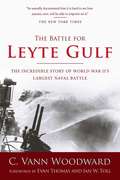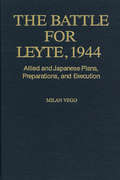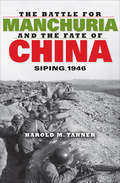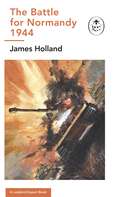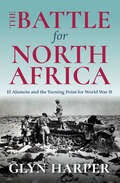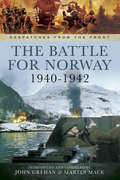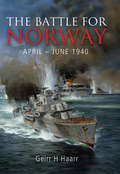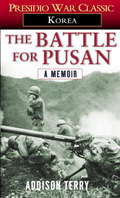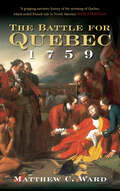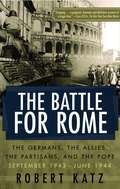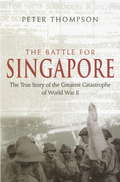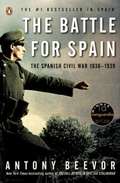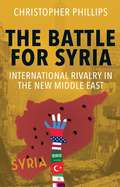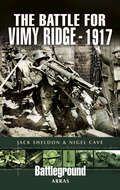- Table View
- List View
The Battle for Laos: Vietnam's Proxy War, 1955–1975 (Cold War, 1945–1991)
by Stephen EmersonA history of the &“secret war&” in Southeast Asia in which nearly three million tons of bombs decimated a newly independent nation. By 1959 the newly independent Kingdom of Laos was transforming into a Cold War battleground for global superpower competition, having been born out of the chaos following the French military defeat and withdrawal from Indochina in 1954. The country was soon engulfed in a rapidly evolving civil war as rival forces jockeyed for power and swelling foreign intervention intensified the fighting. Adding even more fuel to the fire, &“neutral&” Laos&’s geographic entanglement in the war in neighboring South Vietnam deepened in the early 1960s as Hanoi&’s reliance on the Ho Chi Minh Trail for moving men and matériel through the southern Laotian panhandle grew exponentially, making it a priority target of American interdiction efforts. For almost twenty years, the fighting between the Western-supported Royal Lao government and the communist-supported Pathet Lao would rage across the plains, jungles, and mountaintops largely unseen by most of the world. Thousands on each side would die and many more would be displaced as the conflict on the ground ebbed and flowed from season to season and year to year. And in the skies above, American and Royal Laotian aircraft would rain down their deadly payloads, decimating large swaths of the countryside in pursuit of victory. Nearly three million tons of bombs would be dropped on Laotian territory between 1965 and 1973, leaving a legacy of unexploded ordnance that lingers to this day. The battle for Laos is a tale of entire communities and generations caught up in a war seemingly without end, one that pitted competing foreign interests and their proxies against each other and was forever tied to Washington&’s pursuit of victory in Vietnam. This book tells the story of this so-called &“secret war.&”
The Battle for Laos: Vietnam's Proxy War, 1955–1975 (Cold War, 1945–1991)
by Stephen EmersonA history of the &“secret war&” in Southeast Asia in which nearly three million tons of bombs decimated a newly independent nation. By 1959 the newly independent Kingdom of Laos was transforming into a Cold War battleground for global superpower competition, having been born out of the chaos following the French military defeat and withdrawal from Indochina in 1954. The country was soon engulfed in a rapidly evolving civil war as rival forces jockeyed for power and swelling foreign intervention intensified the fighting. Adding even more fuel to the fire, &“neutral&” Laos&’s geographic entanglement in the war in neighboring South Vietnam deepened in the early 1960s as Hanoi&’s reliance on the Ho Chi Minh Trail for moving men and matériel through the southern Laotian panhandle grew exponentially, making it a priority target of American interdiction efforts. For almost twenty years, the fighting between the Western-supported Royal Lao government and the communist-supported Pathet Lao would rage across the plains, jungles, and mountaintops largely unseen by most of the world. Thousands on each side would die and many more would be displaced as the conflict on the ground ebbed and flowed from season to season and year to year. And in the skies above, American and Royal Laotian aircraft would rain down their deadly payloads, decimating large swaths of the countryside in pursuit of victory. Nearly three million tons of bombs would be dropped on Laotian territory between 1965 and 1973, leaving a legacy of unexploded ordnance that lingers to this day. The battle for Laos is a tale of entire communities and generations caught up in a war seemingly without end, one that pitted competing foreign interests and their proxies against each other and was forever tied to Washington&’s pursuit of victory in Vietnam. This book tells the story of this so-called &“secret war.&”
The Battle for Leyte Gulf: The Incredible Story of World War II's Largest Naval Battle
by Evan Thomas C. Vann WoodwardPulitzer-Prize-winner and bestselling author C. Vann Woodward recreates the gripping account of the battle for Leyte Gulf--the greatest naval battle of World War II and the largest engagement ever fought on the high seas. For the Japanese, it represented their supreme effort; they committed to action virtually every operational fighting ship on the lists of the Imperial Navy, including two powerful new battleships of the Yamato class. It also ended in their greatest defeat--and a tremendous victory for the United States Navy. Features a new introduction by Evan Thomas, author of Sea of Thunder.
The Battle for Leyte, 1944
by Milan VegoOne of the largest and most complex military efforts ever undertaken, the Leyte Operation was the Allies' first and most important major combined operation to liberate the Philippine archipelago. The stakes were high: a successful landing at Leyte was critical to a subsequent assault on Luzon and total control of the Philippines. If Japan lost the Philippines, its supply of oil and other strategic raw materials would be cut off and its Navy doomed to an inglorious end. In this comprehensive study, one of the world's leading authorities on the subject addresses all aspects of the two-month-long ground, sea, and air invasion, and presents a complete evaluation of theater-wide command, organization, intelligence, and logistics.Drawing on a wealth of Allied and Japanese primary documents and countless secondary sources, Milan Vego describes and analyzes the operational planning and preparation as well as the execution of actions on both sides. Focusing on the operational versus tactical aspects of the struggle, he critically assesses the major decisions made by the senior commanders. His access to the Allied Magic radio intercepts allows him to shed light on what Allied and Japanese commanders knew and did not know about each other. Unlike other books on the subject, Vego draws conclusions and provides operational lessons learned based on his conclusions. A large number of maps, figures, and tables enhance the text.
The Battle for Manchuria and the Fate of China: Siping, 1946 (Twentieth-Century Battles)
by Harold M. Tanner&“A well-organized and excellently researched work&” (H-War) on one of the crucial battles of China&’s civil war. In the spring of 1946, Communists and Nationalist Chinese were battled for control of Manchuria and supremacy in the civil war. The Nationalist attack on Siping ended with a Communist withdrawal, but further pursuit was halted by a ceasefire brokered by the American general, George Marshall. Within three years, Mao Zedong&’s troops had captured Manchuria and would soon drive Chiang Kai-shek&’s forces off the mainland. Did Marshall, as Chiang later claimed, save the Communists and determine China&’s fate? Putting the battle into the context of the military and political struggles fought, Harold M. Tanner casts light on all sides of this historic confrontation and shows how the outcome has been, and continues to be, interpreted to suit the needs of competing visions of China&’s past and future. &“A genuine addition to our knowledge about this battle and the Chinese civil war in general.&” —Mark Wilkinson, Virginia Military Institute
The Battle for Moscow
by David StahelIn November 1941 Hitler ordered German forces to complete the final drive on the Soviet capital, now less than 100 kilometres away. Army Group Centre was pressed into the attack for one last attempt to break Soviet resistance before the onset of winter. From the German perspective the final drive on Moscow had all the ingredients of a dramatic final battle in the east, which, according to previous accounts, only failed at the gates of Moscow. David Stahel now challenges this well-established narrative by demonstrating that the last German offensive of 1941 was a forlorn effort, undermined by operational weakness and poor logistics, and driven forward by what he identifies as National Socialist military thinking. With unparalleled research from previously undocumented army files and soldiers' letters, Stahel takes a fresh look at the battle for Moscow, which even before the Soviet winter offensive, threatened disaster for Germany's war in the east.
The Battle for Moscow: Riveting Story of the Most Bloody and Barbaric Battle of World War II
by Albert SeatonThe course of human civilization has turned on the outcome of a select few climactic battles throughout history, but never more so than when Stalin's enigmatic Soviet Union desperately rallied its resources to stave off Hitler's armies in the Battle for Moscow. From the drama in the command posts to the plight of the infantry and armor in the mud and snow, Seaton illuminates the titanic struggle that was the pivotal battle of WWII.
The Battle for Normandy, 1944: (WW2 #9) (The Ladybird Expert Series #15)
by James HollandBOOK 9 OF THE LADYBIRD EXPERT HISTORY OF THE SECOND WORLD WAR, FROM AWARD-WINNING HISTORIAN JAMES HOLLANDFeaturing stunning illustrations from Keith Burns, bringing the story to life in vivid detailWhy did the Allies attack on D-Day?How did the Allies pick Normandy as a target?What was Operation Overload, the second front against the Nazis?JUNE 6 1944D-Day was a deciding conflict in World War II. But the invasion was not a straightforward attack.From feeding Nazi spies false information on the attack, to developing new technology like the Mulberry harbours, D-Day changed the course of the War for good.THE LARGEST SEABORNE INVASION IN HISTORYWritten by historian, author and broadcaster James Holland, The Battle for Normandy is an essential introduction to the naval invasion that began the liberation of Western Europe from the Nazis.__________Discover the full Ladybird Expert WW2 series:BlitzkriegThe Battle of BritainBattle of the AtlanticThe Desert WarThe Eastern FrontThe Pacific WarThe Bomber WarThe War in ItalyThe Battle for NormandyThe War in BurmaVictory in EuropeVictory Against Japan
The Battle for North Africa: El Alamein and the Turning Point for World War II (Twentieth-Century Battles)
by Glyn Harper&“A well-researched and highly readable account of one of World War II&’s most important &‘turning point&’ battles.&” —Jerry D. Morelock, Senior Editor at HistoryNet.com In the early years of World War II, Germany shocked the world with a devastating blitzkrieg, rapidly conquered most of Europe, and pushed into North Africa. As the Allies scrambled to counter the Axis armies, the British Eighth Army confronted the experienced Afrika Corps, led by German field marshal Erwin Rommel, in three battles at El Alamein. In the first battle, the Eighth Army narrowly halted the advance of the Germans during the summer of 1942. However, the stalemate left Nazi troops within striking distance of the Suez Canal, which would provide a critical tactical advantage to the controlling force. War historian Glyn Harper dives into the story, vividly narrating the events, strategies, and personalities surrounding the battles and paying particular attention to the Second Battle of El Alamein, a crucial turning point in the war that would be described by Winston Churchill as &“the end of the beginning.&” Moving beyond a simple narrative of the conflict, The Battle for North Africa tackles critical themes, such as the problems of coalition warfare, the use of military intelligence, the role of celebrity generals, and the importance of an all-arms approach to modern warfare.
The Battle for Norway, 1940–1942 (Despatches From The Front)
by Martin Mace John GrehanDespatches in this volume include that on the first and second battles of Narvik in 1940; the despatch on operations in central Norway 1940, by Lieutenant General H.R.S. Massy, Commander-in-Chief, North West Expeditionary Force; Despatch on operations in Northern Norway between April and June 1940; the despatch on carrier-borne aircraft attacks on Kirkenes (Norway) and Petsamo (Finland) in 1941, by Admiral Sir John C. Tovey; the despatch on the raid on military and economic objectives in the Lofoten Islands (Norway) in March 1941, by Admiral Sir John C. Tovey, Commander-in-Chief, Home Fleet; and the despatch on the raid on military and economic objectives in the vicinity of Vaagso Island (Norway) in December 1941, by Admiral Sir John C. Tovey.This unique collection of original documents will prove to be an invaluable resource for historians, students and all those interested in what was one of the most significant periods in British military history.
The Battle for Norway: April–June 1940
by Geirr HaarrThe acclaimed historian and author of The Gathering Storm continues his in-depth study of Northern European naval warfare during WWII. The Nazi invasion of Norway in 1940 was the first modern campaign in which sea, air and ground forces interacted decisively. In this detailed history, Gierr H. Haarr presents a comprehensive study of the naval aspects of the operation. He begins with the events off the coast of southern and western Norway where Norwegian and British forces attempted to halt the German advance out of the invasion ports as well as the stream of supplies and reinforcements across the Skagerrak Strait. Haarr then focuses on the British landings in Central Norway, where the Royal Navy first had its mastery challenged by air superiority from land-based aircraft. Next, he examines the events in and around Narvik where Allied naval, air and land forces were engaged in the first combined amphibious landings of World War II. Finally, Haarr sums up the the evacuation in June, in which the first carrier task force operations of the war, including the loss of the HMS Glorious, figure prominently. As Haarr&’s previous volume, The Gathering Storm, the narration shifts between strategic and operational issues, and the experiences of the officers and soldiers on the frontlines. Extensive research and use of primary sources reveal the many sides of this battle, some of which remain controversial to this day.
The Battle for Passchendaele: Australian Army Campaigns Series 28 (Australian Army Campaigns Series #28)
by Ian FinlaysonThe Battle for Passchendaele on 12 October 1917 was one of the epic struggles of the First World War. British Field Marshal Douglas Haig allocated II ANZAC Corps to capture Passchendaele village, with Major General Monash&’s 3rd Australian Division and the New Zealand Division leading the attack. For both divisions the battle was a bloody debacle. Monash&’s division started the battle with 5800 men and, just 24 hours later, could only muster 2600, suffering horrendous losses for a small territorial gain which was later relinquished. The New Zealand Division was trapped in front of the German wire and barely moved from its start line, suffering one of its highest casualty rates of the war. Fought in conditions which seemed to preclude any chance of success, the battle has become a metaphor for pointless sacrifice. After the battle the British and Australian leadership were unanimous in placing blame for the defeat on the all-pervasive mud. Monash, writing to his wife, believed that his plan &‘would have succeeded in normal conditions&’. Yet, two weeks later, in similar weather and terrain, Lieutenant General Currie&’s Canadian Corps succeeded where Monash and Godley&’s II ANZAC Corps did not. The central focus of this book is a detailed analysis of the 3rd Australian Division&’s plan and execution of the attack on Passchendaele. By examining the differences between the Australian and Canadian plans for the capture of Passchendaele, the author casts this iconic battle in a completely different light. It is a re-examination that is long overdue.
The Battle for Pusan
by Addison TerryIn 1950, North Korean Army forces shocked the world as they streamed across the 38th Parallel in the opening attack of a campaign to unite the peninsula by forces of arms under the communist regime in Pyongyang. Hastily thrown into battle, US forces finally stabilized a defensive perimeter around the south port city of Pusan. But could they hold it?
The Battle for Quebec 1759: Britain's Conquest of Canada
by Matthew C WardA concise and readable history of the British war against the French for control of Canada.
The Battle for Rome: The Germans, the Allies, the Partisans, and the Pope, September 1943 - June 1944
by Robert KatzIn September 1943, the German army marched into Rome, beginning an occupation that would last nine months until Allied forces liberated the ancient city. During those 270 days, clashing factions -- the occupying Germans, the Allies, the growing resistance movement, and the Pope -- contended for control over the destiny of the Eternal City. In The Battle for Rome, Robert Katz vividly recreates the drama of the occupation and offers new information from recently declassified documents to explain the intentions of the rival forces. One of the enduring myths of World War II is the legend that Rome was an "open city," free from military activity. In fact the German occupation was brutal, beginning almost immediately with the first roundup of Jews in Italy. Rome was a strategic prize that the Germans and the Allies fought bitterly to win. The Allied advance up the Italian peninsula from Salerno and Anzio in some of the bloodiest fighting of the war was designed to capture the Italian capital. Dominating the city in his own way was Pope Pius XII, who used his authority in a ceaseless effort to spare Rome, especially the Vatican and the papal properties, from destruction. But historical documents demonstrate that the Pope was as concerned about the Partisans as he was about the Nazis, regarding the Partisans as harbingers of Communism in the Eternal City. The Roman Resistance was a coalition of political parties that agreed on little beyond liberating Rome, but the Partisans, the organized military arm of the coalition, became increasingly active and effective as the occupation lengthened. Katz tells the story of two young Partisans, Elena and Paolo, who fought side by side, became lovers, and later played a central role in the most significant guerrilla action of the occupation. In retaliation for this action, the Germans committed the Ardeatine Caves Massacre, slaying hundreds of Roman men and boys. The Pope's decision not to intervene in that atrocity has been a source of controversy and debate among historians for decades, but drawing on Vatican documents, Katz authoritatively examines the matter. Katz takes readers into the occupied city to witness the desperate efforts of the key actors: OSS undercover agent Peter Tompkins, struggling to forge an effective spy network among the Partisans; German diplomats, working against their own government to save Rome even as they condoned the Nazi repression of its citizens; Pope Pius XII, anxiously trying to protect the Vatican at the risk of depending on the occupying Germans, who maintained order by increasingly draconian measures; and the U.S. and British commanders, who disagreed about the best way to engage the enemy, turning the final advance into a race to be first to take Rome. The Battle for Rome is a landmark work that draws on newly released documents and firsthand testimony gathered over decades to offer the finest account yet of one of the most dramatic episodes of World War II.
The Battle for Singapore: The True Story of the Greatest Catastrophe of World War II
by Peter ThompsonThe true story of the 'the greatest defeat and largest capitulation' in British military history. The Fall of Singapore on 15 February 1942 is a military disaster of enduring fascination. For the 60th anniversary of the liberation of the island, Peter Thompson tells the explosive story of the Malayan campaign, the siege of Singapore, the ignominious surrender to a much smaller Japanese force, and the Japanese occupation through the eyes of those who were there - the soldiers of all nationalities and members of Singapore's beleaguered population. An enthralling and perceptive account, which never loses sight of the human cost of the tragedy - Yorkshire Evening Post. An insightful and dramatic analysis - The Good Book Guide
The Battle for Spain
by Antony BeevorA fresh and acclaimed account of the Spanish Civil War by the bestselling author of Stalingrad and The Fall Of Berlin 1945 To mark the 70th anniversary of the Spanish Civil War's outbreak, Antony Beevor has written a completely updated and revised account of one of the most bitter and hard-fought wars of the twentieth century. With new material gleaned from the Russian archives and numerous other sources, this brisk and accessible book (Spain's #1 bestseller for twelve weeks), provides a balanced and penetrating perspective, explaining the tensions that led to this terrible overture to World War II and affording new insights into the war-its causes, course, and consequences.
The Battle for Spain: The Spanish Civil War 1936-1939
by Antony Beevor'Fascination lies in the human drama, superbly captured by Beevor ... A vivid chronicle of a dreadful time and place' Max Hastings, Sunday Times'A moving masterpiece' TLSThe civil war that tore Spain apart between 1936 and 1939 and attracted liberals and socialists from across the world to support the cause against Franco was one of the most hard-fought and bitterest conflicts of the 20th century: a war of atrocities and political genocide and a military testing ground before WWII for the Russians, Italians and Germans, whose Condor Legion so notoriously destroyed Guernica.Antony Beevor's account narrates the origins of the Civil War and its violent and dramatic course from the coup d'etat in July 1936 through the savage fighting of the next three years which ended in catastrophic defeat for the Republicans in 1939. And he succeeds especially well in unravelling the complex political and regional forces that played such an important part in the origins and history of the war.
The Battle for Spain: The Spanish Civil War 1936-1939
by Antony BeevorThe civil war that tore Spain apart between 1936 and 1939 and attracted liberals and socialists from across the world to support the cause against Franco was one of the most hard-fought and bitterest conflicts of the 20th century: a war of atrocities and political genocide and a military testing ground before WWII for the Russians, Italians and Germans, whose Condor Legion so notoriously destroyed Guernica.Antony Beevor's account narrates the origins of the Civil War and its violent and dramatic course from the coup d'etat in July 1936 through the savage fighting of the next three years which ended in catastrophic defeat for the Republicans in 1939. And he succeeds especially well in unravelling the complex political and regional forces that played such an important part in the origins and history of the war.Read by Sean Barrett(p) 2011 Isis Publishing Ltd
The Battle for Syria: International Rivalry in the New Middle East
by Christopher PhillipsAn unprecedented analysis of the crucial but underexplored roles the United States and other nations have played in shaping Syria’s ongoing civil war Most accounts of Syria’s brutal, long-lasting civil war focus on a domestic contest that began in 2011 and only later drew foreign nations into the escalating violence. Christopher Phillips argues instead that the international dimension was never secondary but that Syria’s war was, from the very start, profoundly influenced by regional factors, particularly the vacuum created by a perceived decline of U.S. power in the Middle East. This precipitated a new regional order in which six external protagonists—the United States, Russia, Iran, Saudi Arabia, Turkey, and Qatar—have violently competed for influence, with Syria a key battleground. Drawing on a plethora of original interviews, Phillips constructs a new narrative of Syria’s war. Without absolving the brutal Bashar al-Assad regime, the author untangles the key external factors which explain the acceleration and endurance of the conflict, including the West’s strategy against ISIS. He concludes with some insights on Syria and the region's future.
The Battle for Syria: International Rivalry in the New Middle East
by Christopher PhillipsAn unprecedented analysis of the crucial but underexplored roles the United States and other nations have played in shaping Syria’s ongoing civil war“One of the best informed and non-partisan accounts of the Syrian tragedy yet published.”—Patrick Cockburn, Independent Syria’s brutal, long-lasting civil war is widely viewed as a domestic contest that began in 2011 and only later drew foreign nations into the fray. But in this book Christopher Phillips shows the crucial roles that were played by the United States, Russia, Iran, Saudi Arabia, Turkey, and Qatar in Syria’s war right from the start. Phillips untangles the international influences on the tragic conflict and illuminates the West’s strategy against ISIS, the decline of U.S. power in the region, and much more. Originally published in 2016, the book has been updated with two new chapters.  
The Battle for Tinian: Vital Stepping Stone in America's War Against Japan
by Nathan N. PreferThis vivid history chronicles the decisive US naval campaign that secured the Japanese island of Tinian—the site that would launch the end of WWII. In July 1944, the United States Navy and Marine Corps, Army, and Air Corps descended on the Pacific island of Saipan, just three miles away from the Japanese stronghold on the island of Tinian. There had been 20,000 Japanese troops on Saipan before the US unleashed a horrific all-arms campaign. The sudden silence indicated it was now Tinian&’s turn. When the battle for Tinian finally took place, the US acted with great skill. Historian Samuel Elliot Morrison called it &“the most perfectly executed amphibious operation of the entire war.&” Nevertheless, the Japanese shore batteries riddled the battleship Colorado, killing scores, and made multiple hits on a destroyer, killing its captain. On the island itself, the United States used napalm for the first time, paving the way for Marines rooting out strongpoints. One last banzai attack signaled the end to enemy resistance, as Marines fought toe-to-toe with their antagonists in the dark. After Tinian was secured, the United States built the biggest airport in the world there—home to hundreds of B-29 Superfortresses. Among these, just over a year later, were the Enola Gay and Bockscar, which, with their atomic bombs, would quickly bring the Japanese conflict, and the Second World War, to an end.
The Battle for Veterans’ Healthcare: Dispatches from the Front Lines of Policy Making and Patient Care
by Suzanne GordonIn The Battle for Veterans' Healthcare, award-winning author Suzanne Gordon takes us to the front lines of federal policymaking and healthcare delivery, as it affects eight million Americans whose military service makes them eligible for Veterans Health Administration (VHA) coverage.Gordon’s collected dispatches provide insight and information too often missing from mainstream media reporting on the VHA and from Capitol Hill debates about its future. Drawing on interviews with veterans and their families, VHA staff and administrators, health care policy experts and Congressional decision makers, Gordon describes a federal agency under siege that nevertheless accomplishes its difficult mission of serving men and women injured, in myriad ways, while on active duty.The Battle for Veterans’ Healthcare is an essential primer on VHA care and a call to action by veterans, their advocacy organizations, and political allies. Without lobbying efforts and broader public understanding of what’s at stake, a system now functioning far better than most private hospital systems may end up looking more like them, to the detriment of patients and providers alike.
The Battle for Vimy Ridge, 1917 (Battleground Arras Ser.)
by Nigel Cave Jack SheldonIn a new departure in the Battleground Europe series, this book is a guide to both sides of a major battle in this case to the Canadian Corps operations against 1st Bavarian Reserve Corps at Vimy from 9 12 April 1917, which formed part of the opening of the British offensive, known as the Battle of Arras. Historically, the capture of Vimy Ridge was an event far more significant than its undoubted military importance alone. Here for the first time all four divisions of the Canadian Corps were deployed in line together in one offensive; and although the Corps went to fight even greater battles, Vimy marked a key point in the emergence of Canada as a fully sovereign nation.Although the Canadian side of the story has been well chronicled by a number of writers, until now there has been little concerning the defense during this great battle. Now, the accounts of the German soldiers and their commanders are combined with those of the Canadians and British deployed on the other side of No Mans Land and not simply those who fought above ground, but tunnelers also.
The Battle for the Caucasus, 1942–1943: Rare Photogaphs from Wartime Archives (Images of War)
by Anthony Tucker-JonesIn late 1942 Hitler's forces advanced far into the Caucasus in the southern Soviet Union in one of the most ambitious offensives of the Second World War, but this extraordinary episode is often forgotten-it is overshadowed by the disastrous German attack on Stalingrad which took place at the same time. Using over 150 wartime photographs Anthony Tucker-Jones gives the reader a graphic, concise introduction to this remarkable but neglected campaign on the Eastern Front.Operation Edelweiss was designed to seize the oil fields of Maikop, Baku and Grozny. Seen by some as a wholly unnecessary diversion of resources from the critical confrontation at Stalingrad, the assault on the Caucasus aimed to secure oil supplies for the Germans and deny them to the Soviets.As this memorable selection of photographs shows, the Werhmacht came close to success. Their forces advanced almost as far as Grozny, famously raising the Nazi flag over Mount Elbrus, the highest peak in the region, before they were compelled into a hurried withdrawal by the rapid deterioration of the German position elsewhere on the Eastern Front.

